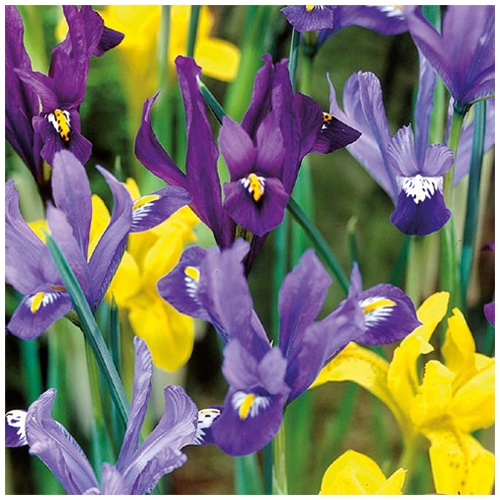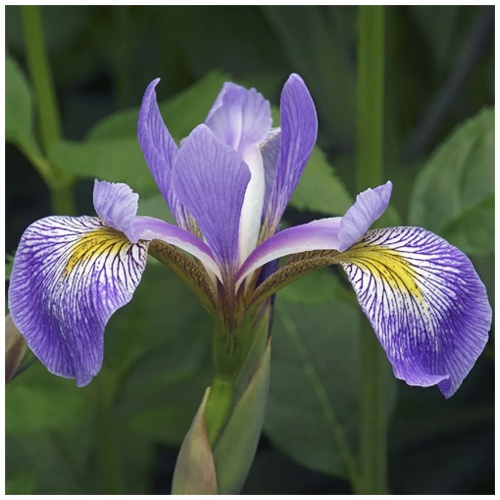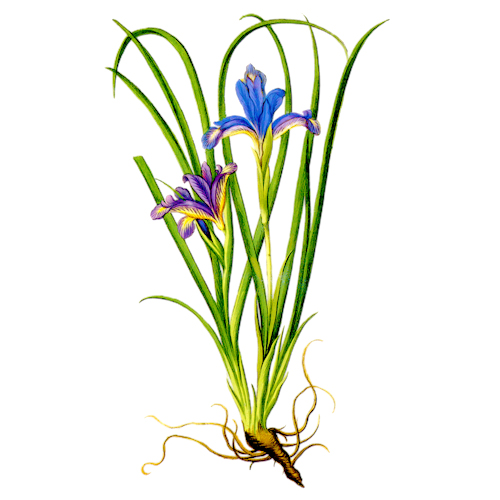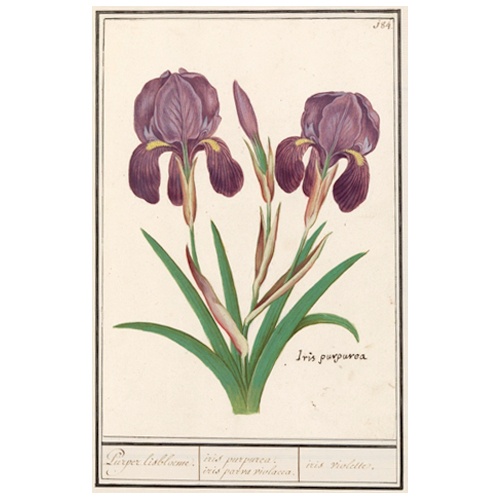
|
|
CULTURAL AND WILD PLANTS
Iris (iris). Legends, myths, symbolism, description, cultivation, methods of application
Directory / Cultivated and wild plants Content
Iris (iris), Iris. Photos of the plant, basic scientific information, legends, myths, symbolism
Basic scientific information, legends, myths, symbolism The genus Iris belongs to the Iridaceae family. Plants of this genus are common in temperate and subtropical zones around the world. The chemical composition of irises is varied and depends on the species. In many types of irises, essential oils, anthocyanins, tannins, flavonoids and other biologically active substances are released. Irises are widely used in landscape design, as ornamental crops and for flower arrangements. In addition, the natural indigo dye can be obtained from the roots of the iris, which is used in the textile industry. Some types of irises are also used in medicine and cosmetology. Legends, myths, symbolism: In Greek mythology, the iris was associated with the goddess Iris, the messenger and novice of the most important god Zeus. She was represented as a winged woman who flew across the rainbow to deliver messages and wishes from the gods. In another Greek legend, the iris came from the blood spilled by the hero Iphigenia, who was killed by his father. A beautiful flower arose from the blood, which became a symbol of courage and honor. In ancient Egypt, iris was a symbol of life and eternity. The Egyptians used iris for medicinal purposes and as an ingredient in perfumes. In Roman mythology, the goddess of love, Venus, created the iris to show people beauty and love. In Chinese mythology, the iris was a symbol of happiness and longevity. It was also believed that iris could protect against evil spirits and bring good luck. Iris is a symbol of faith, wisdom and hope. It can also be used as a symbol of power and nobility. In the culture of a number of peoples, iris is associated with princesses, as its long leaves resemble a dress. It can also be used as a symbol of feminine beauty and grace. The iris can also be used as a symbol of grief and sadness, especially as a symbol of mourning at funerals.
Iris (iris), Iris. Description, illustrations of the plant Iris. Legends, myths, history
The name of the flower was given by the famous healer Hippocrates, who named the plant in honor of the ancient Greek goddess Irida, who proclaims to people the will of the Olympic gods. The golden-haired goddess Iris descended on the rainbow to the ground, so the word "iris" in Greek means rainbow. According to ancient Greek mythology, the rainbow goddess Iris (Irida) fluttered on light, transparent, iridescent wings across the sky and carried out the instructions of the gods. People could see her in raindrops or on a rainbow. In honor of the golden-haired Iris, a flower was named, the shades of which were as magnificent and varied as the colors of the rainbow. The xiphoid leaves of iris symbolize courage and courage among the Japanese. This is probably why in Japanese "iris" and "warrior spirit" are denoted by the same hieroglyph. In Japan, there is a holiday called Boys' Day. It is celebrated on May 5th. On this day, in every Japanese family where there is a son, many objects with the image of irises are exhibited. From the flowers of iris and orange, the Japanese prepare a drink called "May pearls". The Japanese believe that drinking this drink will instill courage in the souls of future men. In addition, according to Japanese beliefs, "May pearls" have healing properties, it can cure many ailments. In ancient Egypt, irises were considered a symbol of eloquence, and in the East they symbolized sadness, so white irises were planted on graves. According to legend, the first iris blossomed several million years ago and was so beautiful that not only animals, birds and insects came to admire it, but also water and wind, which then spread the ripened seeds all over the earth. And when the seeds sprouted and blossomed, the iris became one of man's favorite plants. From a distance, irises seem like small beacons showing the way to sailors. Irises sprouted, according to a Pomeranian legend, from the tears of a fisherwoman, who often mourned her separation from her husband.
And here is another legend about irises. Once a rainbow, before disappearing, crumbled into pieces. Wonderful fragments of the rainbow fell to the ground and charming flowers sprouted. The rainbow crumbled into small fragments - that's where the irises bloomed. Another legend tells. When the titan Prometheus stole heavenly fire on Olympus and gave it to people, a rainbow flared up on earth with a marvelous seven-color rainbow - so great was the joy of all life in the world. Already the sunset has faded, and the day has faded, and the sun has gone, and the rainbow still shone over the world, giving people hope. She did not go out until dawn. And when in the morning the sun returned to its place again, where the magic rainbow burned and shimmered with colors, irises bloomed. Iris flowers have been known to man since ancient times. On the island of Crete, a fresco on the wall of the Palace of Knossos depicts a priest surrounded by blooming irises. This fresco is about 4000 years old. Iris flowers are imprinted in the stone of Oriental and Roman galleries and balustrades. In the Middle Ages, they grew in the gardens of castles and monasteries, from where they were transferred to the gardens of the townspeople. Arabs in ancient times planted wild iris with white flowers on the graves. And in ancient Egypt, it was bred back in the XNUMXth-XNUMXth centuries BC, and it was a symbol of eloquence there. In Arabia, on the contrary, they were a symbol of silence and sadness.
In the Russian Empire, the word "iris" appeared as a botanical name for plants in the second half of the XNUMXth century, and before that period they used the popular name "iris", the inhabitants of Ukraine called irises "cockerel". In Bulgaria, Serbia and Croatia, the iris is called "Perunika" - in honor of the Slavic god Perun. The Slavic peoples widely used an iridescent range of colors and shades and bizarre forms of iris inflorescences. They could be seen in folk crafts, in the textile industry, as well as in everyday life decoration: painting dwellings, utensils, clothes (in the ornament of shirts, sundresses, towels, shawls and half-shawls). Author: Martyanova L.M.
Iris. Interesting plant facts
“The color of its own flowers tells the iris its name: after all, the flowers of its color are similar to the heavenly Irida. It is called Illyrian because it was born abundantly in the region of Illyria,” the French doctor of the XNUMXth century, Odo from Maine, tells us the pedigree of the flower. The iris has leaves that are flat like swords, and therefore the Germans call it the sword-lily, and the Russians, for its beauty, gave the iris the gentle name of iris. More than others similar to the Greek iris Florentine iris. Its pale satin flowers seem to admire themselves and on the dark green of the grass are very similar to a fading rainbow. The ancient Greeks called the rainbow an iris, and therefore a flower similar to a rainbow in color began to be called an iris, considering the flowers to be fragments of a rainbow that fell to the ground. And indeed, nature gave iris all the colors of the rainbow: pink and bronze-crimson, azure and sapphire, lilac and purple-cherry, lemon and orange-yellow, snow-white and bluish black. Irises have beautiful not only flowers, but also leaves that remain green until late autumn. A pleasant smell, elegance and the ability to stay fresh for a long time after cutting (buds open one after another) make it possible to rank irises among the most valuable plants. In culture, they have been known for over two thousand years and are revered not only for the beauty of flowers, but also for the aroma of the root, extracts from which are used in the manufacture of high-quality perfumes, liqueurs, wines and confectionery. Mats, ropes, brushes are prepared from the leaves of the Dzungarian and viscous iris in many countries, and their roots are used for tanning leather. The powerful root system of plants allows them to be used to fix ravines, steep slopes, slopes. But the main advantage of plants continues to be the beauty of flowers. From a distance, irises seem like small beacons showing the way to fishermen, and, according to a Pomeranian legend, they sprouted from the tears of a fisherwoman who often mourned her separation from her husband. Arabs in ancient times planted wild iris with white flowers on the graves. And in ancient Egypt, it was bred back in the XNUMXth-XNUMXth centuries BC, and it was there as a symbol of eloquence. From Egypt, the flower came to Spain, France, England, Russia and other countries. The iris family includes about 1800 species belonging to eighty genera. The range of this family covers almost the entire land of the globe: even within the same genus, you can find all sorts of color options for flowers, from pure yellow to blue-violet. The genera of iris also differ significantly in flowering time from one day to a month. Irises are good at any time of the day, but they are especially charming in lunar illumination: depending on your own imagination, you can see sparkling snow, the glare of dawn, and the golden sun, and the sea surface, and the red sunset, and the onset of night. In any Japanese family with sons, on the traditional boys' holiday on May 5, images of irises flaunt on many items. On this day, a magical talisman from many diseases, the so-called "May pearls", is prepared from the flowers of iris and orange, and it is prepared because in Japanese the names of iris and the words "warrior spirit" are denoted by the same hieroglyphs. "May pearls", according to legend, should instill courage in the soul of a young man. It is easy for the uninitiated to believe this, since even the leaves of the plant are very similar to swords. In Rus', among the peaceful names of iris, such as cockerels, magpie flowers, luziki, tummies, pigtails, there is also a military name for the plant, however, with a noticeable degree of irony - a frog spear. However, the most common name is still iris, which should be understood as cute, dear, beloved and desired.
What kind of irises does not exist on earth. The dwarf iris, for example, rises only a few centimeters above the ground, and its purple flowers seem to be stuck right into the ground. But the lavender-blue or snow-white-white flowers of the giant blue iris with evergreen leaves flaunt almost at a sage height. According to legend, the first iris blossomed several million years ago at the edge of subtropical forests in Southeast Asia. It was so beautiful that not only all animals, birds and insects gathered to admire it, but even water and wind, which then carried the ripened flower seeds around the globe. And when the seeds sprouted and blossomed, iris flowers became one of the favorite plants of man. Florence was named Florence by the Romans only because irises grew in abundance around this Etruscan settlement, and the literal translation from Latin into Russian "Florence" means "blooming". However, many species of wild irises are now becoming rare and are listed in the Red Book of Protected Plants. Author: Krasikov S.
Iris (iris). Useful information
In May, it blooms in gardens with beautiful large flowers - yellow, purple and lilac - iris or iris. Iris has bluish saber-shaped leaves and a thick rhizome. The rhizome must be gradually dried, then essential oils are formed in it, which have the smell of violets. The rhizome of the iris is therefore incorrectly called "violet root". From the rhizome of the iris, one of the most expensive oils is distilled - iris, with a strong aroma. A fragrant powder is made from the rhizome of the iris, which is poured into bags and placed in the drawers of the closet with linen to give the linen a pleasant smell. Iris has another incorrect name - "Florentine lily". At first, the lily flower was in the coat of arms of Florence, and from the XNUMXth century it became the coat of arms of France. France was called the kingdom of the lilies. But the lilies on the coat of arms of royal France were not lilies, but irises: on the coat of arms, some flower petals are raised up, while others are bent down, just like an iris. Author: Verzilin N.
Iris. Application in cosmetology
Iris rhizomes contain a very valuable essential oil with a strong pleasant smell. Iris rhizomes are dug up in autumn. They take only from 2-3-year-old plants, thoroughly washed in running water, cut off the stems and thin thread-like roots and peel the outer bark. The crushed rhizomes are ground into a gruel, which is used to prepare therapeutic and tonic masks. Withstand the mask for 10-20 minutes, rinse with warm water, and then lubricate the skin with a nourishing cream. With dry and inflamed skin, the mask should be used carefully, add whole milk, cream, sour cream or a little goose fat to the gruel. Author: Reva M.L.
Iris (iris), Iris. Recipes for use in traditional medicine and cosmetology
Ethnoscience:
Cosmetology:
Attention! Before use, consult with a specialist!
Iris (iris), Iris. Tips for growing, harvesting and storing
Iris (lat. Iris) is a plant of the Iridaceae family, which is known for its beautiful flowers of various shades. Tips for growing, harvesting and storing irises: Cultivation:
Workpiece:
Storage:
▪ Bergamot ▪ Play the game "Guess the plant from the picture"
Energy from space for Starship
08.05.2024 New method for creating powerful batteries
08.05.2024 Alcohol content of warm beer
07.05.2024
▪ The screw remembers the shape ▪ Raelclear Double Sided Transparent TV ▪ Mercedes-Benz C-Class with autopilot
▪ section of the site Personal transport: land, water, air. Article selection ▪ article It was recently, it was a long time ago. Popular expression ▪ Article How many kilometers does a person walk in his life? Detailed answer ▪ article General information about the atmosphere. Travel Tips ▪ article Distribution of electricity. Encyclopedia of radio electronics and electrical engineering ▪ article Antenna Eagle. Encyclopedia of radio electronics and electrical engineering
Home page | Library | Articles | Website map | Site Reviews www.diagram.com.ua |






 Arabic
Arabic Bengali
Bengali Chinese
Chinese English
English French
French German
German Hebrew
Hebrew Hindi
Hindi Italian
Italian Japanese
Japanese Korean
Korean Malay
Malay Polish
Polish Portuguese
Portuguese Spanish
Spanish Turkish
Turkish Ukrainian
Ukrainian Vietnamese
Vietnamese










 See other articles Section
See other articles Section 